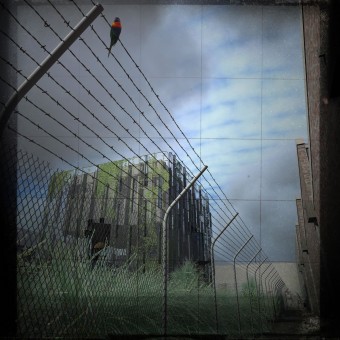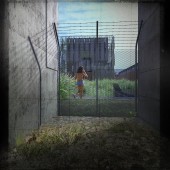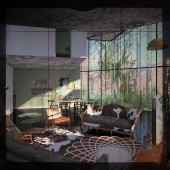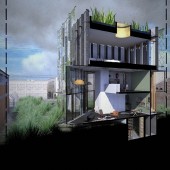DESIGN NAME:
Green Cage
PRIMARY FUNCTION:
Residential Residence
INSPIRATION:
Interface of Architecture to the intimacy of a garden
UNIQUE PROPERTIES / PROJECT DESCRIPTION:
The design intent was to look at an residential and pottery / art studio insertion to a bare inner city lot, surrounded by a motley crew of existing industrial buildings. The concept evolved into designing an oasis, abundant with nature within such a concrete and brick clad environ for the interface of Architecture to the intimacy of a garden.
The concept of the Green Cage is a contained ideal of the greening of one’s own backyard. In-short, a blurring of the boundary between the landscape and building through a sharing of space. No thought exists of a secreted walled garden but reversed with the garden forming the walls and secreting the house and studio. The Green Cage has been designed for what will over-grow it. Designed to sit proudly; upright within furrowed earthen mounds covered in creeping ivy; undulating like frozen emerald waves and amongst the sudden splash of exploding tall native grasses. The Green cage is designed for the past, now and the future. Purposed as a functioning house and studio, existing as a part of the fabric of urban Melbourne and yet alien, existing as both a familiar and yet an unfamiliar edifice.
OPERATION / FLOW / INTERACTION:
The project is made of three parts and public interface - Each part has a loose basis on the classical concept of the Ode: the Strophe (Garage), the Antistrophe (House), and the Epode (Studio).
The first contained on the site parcel is the Garage. This sits aligned with neighboring buildings, except that the Garage has been designed for visual porosity; allowing glimpses of what is contained within the Garage and beyond. Above the Garage is a Deck, looking out across the space between the Garage and House, above floats a mono-pitched membrane tent allowing filtered sunlight to the Deck and thru the grated flooring to the Garage below.
Leading from the back of the Garage a raised grating walkway carries you over the lushly planted site to the House, partly raised above the site by a sunken Cellar. The House is of 4 main components that addresses the site, sunlight entry and amenity, containing occupational processes that constitutes such a house.
- The first component is the cage, a galvanized frame with link-wire dressing allowing over growth of vines and creepers. Within this living outer skin is tucked thin shards of crystal glass within voids of the link-wire, deflecting sunlight into the internal spaces as would a prism.
- The second component is the Ground Floor box, a fully glazed entity that gives a view of the site through the green slip of the cage. The Kitchen, Dining and Living spaces are as one, with a toilet tucked to the rear with Laundry equipment to the end of the Kitchen. Beyond the toilet is the access stair to the Cellar (fourth component). A vertical timbered screen with interwoven stair treads moves vertically from the ground to a landing accessing the Mezzanine Level, still part of the open planning over-looking the 'public' areas of the house and beyond to the site. The Mezzanine contains an office, separating its operation from the daily hustle of the home, whilst connecting visually and audibly to the Living spaces below. The timber stair continues to the third component, the private realm of the Bedroom and associated En-suite.
- The third components physical and mental volume differs with the outer shell now solid with rhythmically placed slit windows allowing only controlled glimpses of beyond. Aligned with these slit windows are the crystal glass shards, ensuing light penetration. The whole geometry has been twisted at the centre, rotating the Bedroom 45 degrees. To the roof perimeter a glazed skylight allows further light directly over the stair and En-suite. A centrally placed ocular skylight emits sunlight, allowing a measure of time through the movement of the suns brilliance to internal surfaces. Atop this volume a roof pond fully planted with reeds and other water nesting flora gives a stabilized thermal rating. The pond is fed water from rain and processes grey water for re-use following filtration for toilet flushing.
- The fourth component is the Cellar, which the whole ensemble sits upon, allowing the overall ensconce to seemingly float above the site through a perimeter set-back and the creation of a shadow line. This space is then connected visually with the Ground Floor via an ocular skylight - emitting daylight, levelled with the floor finish.
Continuing from the back of the house a further raised grated walkway leads to a sunken Studio, purposed for pottery. This is differs from the Garage which sits atop the land, the House partly in, and the Studio fully dug into the landscape. Connection to the site is by a sloping down of the grassed ground back to a strip glazed front that looks up and back to the House. Again like the Houses connection to the sky and Cellars connection to the Living an ocular skylight allows further sunlight penetration to the Studio and reading of the suns progress across the sky. Three parts, three functions, serving as one entity. The greening of the physical and mental scape: The Green Cage.
“Most people would look at an animal in a cage and instinctively feel that it should be set free - It's a dangerous world out there, filled with predators - What would you prefer? A comfortable, safe, warm, cosy life in a cage, or an uncertain life of freedom.” - Going Out, written by Scarlett Thomas, 2004.
PROJECT DURATION AND LOCATION:
Carried out over the last half a year whilst living in Melbourne, as a direct Ode to the intimacy of the lane-ways and inner urban areas of Melbourne cities fabric.
FITS BEST INTO CATEGORY:
Architecture, Building and Structure Design
|
PRODUCTION / REALIZATION TECHNOLOGY:
Constructed from a simple palette of materials: Concrete and steel structure, with steel joinery with double glazing infills. Canopies above doors to the house folded brass sheeting left to oxidize, with expanded acid blackened steel tread grating to the above site walkways. The cage to the exterior of the House is a galvanized steel tubing with stainless steel link wire mesh. Outer walls to the Houses Bedroom chamber are highly insulated sandwich panels with wood fibre insulation. The Garage structure is wholly steel, with timber structure to the walkway and stair access to the Deck. The roof is a mono-pitched structure using galvanised steel tube frame with stretched fabric membrane allowing light transmittance. Like the walkways the Decks flooring is again the expanded acid blackened steel grating.
SPECIFICATIONS / TECHNICAL PROPERTIES:
-
TAGS:
House, Residential, Green, Sustainable, urban landscape
RESEARCH ABSTRACT:
-
CHALLENGE:
The site chosen was within a mixed zoning for high intensity living and industry making the siting and massing able to cope with a higher than average 'house'. The feeling of the design takes in a great deal of what Melbourne is as a city. Its feeling of the intimacy of the lane-ways (majority of are old service lanes) and narrow lots set within an industrialized area gave bountiful design challenges for form, function and aesthetic interfaces of the building back to the site. The design is fully realizable by the material selection and structural set-out. It creates a challenging symbiotic relationship of the House to the landscape; here an emerald jewel lost within the folds of industry and the cities fringe.
ADDED DATE:
2011-07-20 16:58:48
TEAM MEMBERS (1) :
IMAGE CREDITS:
Jonathan A Gibb, 2011.
|










